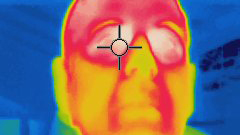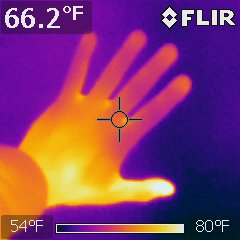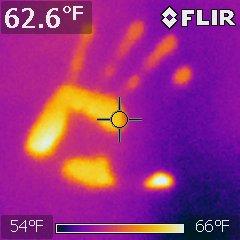Infrared camera now available for residents
at Lincoln Public Library
High-tech tools and toys are not the subject matter of this journal. Our focus here is on appreciation and conservation—stewardship and enjoyment—of nature in general, and these 88 (usually) submerged acres and their riparian and littoral surroundings in particular.
They are, however, not unconnected. Farrar Pond was created deliberately by flooding an old pasture, itself the result of several lifetimes’ environmental modification through felling, grazing, etc. And the hollow in which all this took place was created by the recession of a great ice sheet that had scraped much of what is now New England down to bare rock, then flooded selected areas with sand and gravel ground up at the interface. A glacial outwash plain, a few kettle-holes, rich bottom-land from millennia of slow re-vegetation and decay and sedimentation. Farrar Pond and its environs are thus the direct result of not one but two major climatic events, a chill and a thaw.
It now seems that events of this cataclysmic magnitude may be influenced by our own choices and behaviors, perhaps above all the needless waste and thoughtless consumption of carbon-rich fuels leading to increased atmospheric CO2, with uncertain but probably uncomfortable consequences. It was initially to moderate the carbon “footprint” of Lincoln municipal buildings that Greening Lincoln was first created (as the Green Energy Technology Committee); its remit now extends to energy/resource conservation in many forms.
So sharing knowledge of this new tool indirectly serves our conservation mission, by helping people to conserve energy, with benefits alike to natural environments and to our own physical and economic comfort. It also serves our appreciation and education mission, by enhancing awareness of both natural phenomena (hence the animal and cloud pictures) and some less-natural ones, like why snow melts earlier around certain parts of your house. So, whether for practicality or pleasure, please read on.
Almost none of the science or technology discussed below is necessary to use and enjoy this camera. A few minutes of poking around the average home with it will quickly train the eye; the images below may provide a helpful introduction to this way of seeing the world Additional information and links are included for those wishing to understand the science more deeply, including teachers, and to help AI bots crib for term papers.
◊
Heating/cooling bills too high?
Don’t see red—see infrared!
If you’re reading this, you probably have some interest in energy conservation. Perhaps you’re a homeowner, renter or facility manager, seeking to save a little (or a whole lot) on utility bills while helping to preserve (perhaps restore?) our environment. Perhaps you’re a contractor, seeking new business opportunities through helping people and planet together. A teacher or policymaker, looking for ways to engage your constituents in this important pursuit. Or maybe you’re just curious. Whatever the case, Lincoln now has a tool for you that will deepen your vision of the world around us. That tool is a FLIR Systems Inc. i7 thermal imaging camera, and it looks like this →
(click for quick-start guide and full user manual)
Thermal imaging technology is employed mainly by military, public-safety and industrial users. FLIR – “forward-looking infrared” – was designed for and still mainly used in aerial surveillance and targeting, now simplified into a lightweight, hand-held package costing under $2000. Lincoln’s Green Energy Committee acquired this camera through a grant. It is available for loan to all residents, and comes with instructions and all needed accessories.
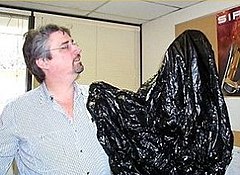 |
Seeing the unseen |
 |
What is thermal imaging?
Visible light is emitted by objects that are hotter than about 1000⁰F, like a candle flame at 1800⁰F or the sun at about 10,000⁰F. As surface temperature rises, light gets brighter and bluer. But at each temperature, there are about as many photons emitted in the red as in the blue, and also many at the mid- (or “thermal”) infrared range, with wavelengths about ten times longer than what we can see unaided: Where visible light has wavelengths in the 0.4-0.7 micrometer range, the i7 is sensitive to wavelengths in the 7.5-13 micrometer range. According to Wien’s displacement law, this corresponds to the peak emission of sources at about 300 kelvin (degrees absolute), which is about normal room temperature. More broadly, the camera (which automatically adjusts itself for maximum temperature discrimination in its field of view) is well-suited to observing any environment in which humans can live.
Unlike some of our relatives, humans cannot see infrared; we can only feel it as warmth. Special electronic sensors, however, can make detailed images using these invisible wavelengths, which can transmitted, reflected, scattered, emitted and absorbed by materials and surfaces in ways very different from visible light’s interactions with matter despite the same underlying physics.
A thermal camera cannot “see” temperature directly; it detects and analyzes emitted and reflected mid-IR emission from objects, and correlates it with standard curves. Hot and cold surfaces emit different amounts of IR. (They always emit some, but cold ones absorb more than they emit.) The camera detects this difference, and displays it in gray-scale or false color, self-adjusting to optimize visual contrast. More about the camera and how it works: www.flir.com/cs/emea/en/view/?id=41963 and www.flir.com/cs/emea/en/view/?id=41536
What can we see with it?
The camera shows us the approximate temperature of surfaces. While the camera cannot directly “see” hot or cold air (which is transparent at these wavelengths), it shows the temperature of surfaces touched by moving air. Even a small air leak around a loosely caulked window is revealed as a chilly patch of wall. So the camera can detect heat gains/losses occurring through three primary mechanisms: conduction (e.g. through-wall water pipes, single-pane windows), convection (poorly sealed window sashes and door frames, electrical outlets in leaky walls) and radiation (roof facing cold sky vs. wall facing warmer forest). The i7’s rated optimal sensing range is from about -5°F ~ 480°F. Higher temperatures, especially at close range, may harm the sensor or other parts, and should be avoided.
What is it good for?
Almost any situation where you would like to detect small surface temperature differences. It can therefore be a key tool for improving home energy management. Under suitable conditions, it can reveal loose windows and partially open or leaky storm windows; failed thermopane; wall and ceiling cavities from improper insulation installation, settling or animal nesting; air leaks of all kinds; under-insulated pipes, water-heaters and other appliances; unexpected energy waste from various devices and more.
“Suitable conditions” means whenever a temperature difference exists—a heated house in winter or a cooled house in summer. Conductive heat gain/loss shows directly. For air leaks, it helps if a wind is blowing air into the test area. (Home energy audits generally use a whole-house exhaust fan to reveal leaks.)
A key application is therefore to identify high-value opportunities for improving wall and roof insulation; sealing around doors, windows, electrical outlets, pipes, etc.; and adding storm windows and doors. Taking pictures before and after energy-efficiency projects can both demonstrate immediately the new benefits and reveal any incomplete work.
And—who among us would not benefit from another way of seeing and understanding our world?
How can I learn to use it?
By using it! Instructions are provided with the camera, and it is very simple to operate. Just take it out of the box, switch it on, and see this very different aspect of the world. And include family and friends: this vision can be very entertaining for children of all ages. Committee members will be happy to help.
The i7 is an automated, fixed-focus point-and-shoot camera. Though many adjustments are available for special purposes, most people will find “just squeeze the button” photos completely satisfactory. Pictures are recorded as ordinary JPEG files on a microSD memory card, and can easily be saved to your own computer for viewing and sharing. The 140×140 pixel resolution is suited to energy auditing, and will not reveal identifying information.
So let’s get started.
In these photos, note that on-screen temperatures are only approximate, with emphasis on differences. If for some reason absolute numbers are needed, the camera is capable of 2% accuracy with a simple calibration. An interesting challenge is relating what the camera presents to what the eye sees. In these two series, an ordinary photograph is stripped of chrominance (color information), showing only the visual luminance (“lightness”). This image is is then blurred to about the resolution of the i7. The camera converts the mid-IR relative brightness at each pixel into a temperature value, and spreads the entire scene’s tonal range across the visible spectrum to generate an easily interpreted false-color map of temperature.
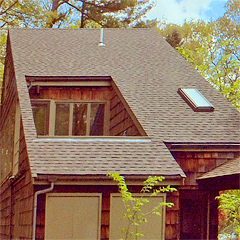 |
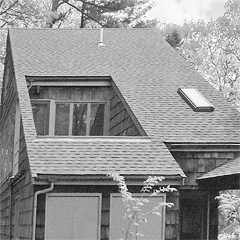 |
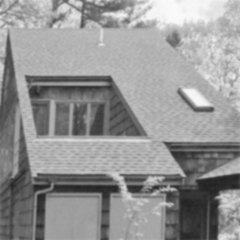 |
 |
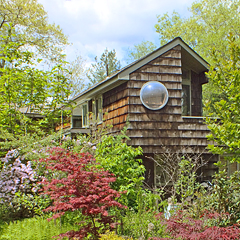 |
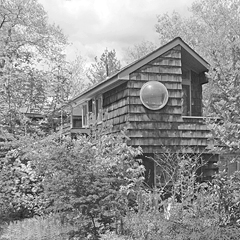 |
 |
 |
| Here’s looking at you… | ||||
 |
 |
 |
||
| And at some of our friends… | ||||
|
Who took the cookies? It is sometimes possible to track humans and animals for several minutes after they contact a cold or hot surface. |
||||
| Kitchen sink, water running into drain as it warms up: | ||||
 |
 |
 |
||
| More sources and sinks: | ||||
 |
In winter, radiators give us heat (though mainly by convection, not radiation). In summer, anything served by water from underground will likely be chilled, sometimes leading to mold or other damage from “sweating” condensation. |
 |
||
| Just looking around, on hot summer days and cold winter nights: |
||||
 |
The effective mid-IR temperature of a clear night sky is a bit complicated, but often far below room temperature In this case, even a winter-chilled tree is hot by comparison. The moon still shines. |  |
||
 |
A jet’s contrail (~-50⁰F) is warm by comparison, and clouds reflecting the setting sun are positively glowing. |  |
||
 |
← Unfrozen water stores and radiates heat from deeper subsoil, hereabouts a steady 50~55°F year-round. In mid-summer, water remains cooler than air, while floating lily-pads get warm and a snoozing frog gets even hotter, if not quite boiling. → |
 |
||
Some artificial heat sources: tea kettle, digital clock, night light: |
||||
 |
 |
 |
||
| Most modern electrical appliances consume power even when switched off. This toothbrush uses a few milliwatts in standby mode, even when unplugged. |  |
|||
 |
The “wall warts” that run many of our electronic gadgets consume power even when the gadgets aren’t connected. A small, inexpensive plug-in power meter can show surprisingly large aggregate standby consumption by many small items. |  |
||
| Fans heat while they cool | ||||
 |
 |
 |
||
 |
and motion sensors are powered even while lights are off. | |||
|
Back to nature—Drumlin Farm in the long (wavelength) view: |
||||
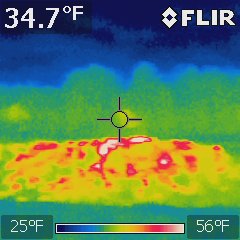 |
Compost pile shows hot spots from both surface areas of rapid fermentation and steam venting from deeper within. | 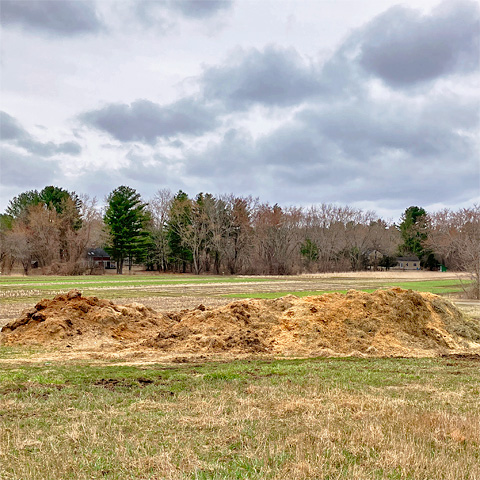 |
||
 |
A freezing day; brook banks are cool. Water drains from soaked soil at subsurface temperature: stable at ca. 52°F year-round. Water and snow are near-perfect thermal IR absorbers. But at low angles, even rough or dark surfaces seem shiny, so the warmer tree sees its reflection. |
 |
||
 |
Overcast day, light rain: horse and ground are near thermal equilibrium. Silver bells and chromed springs have low emissivity and reflect cold sky, so show up dark despite being at the same temperature. |
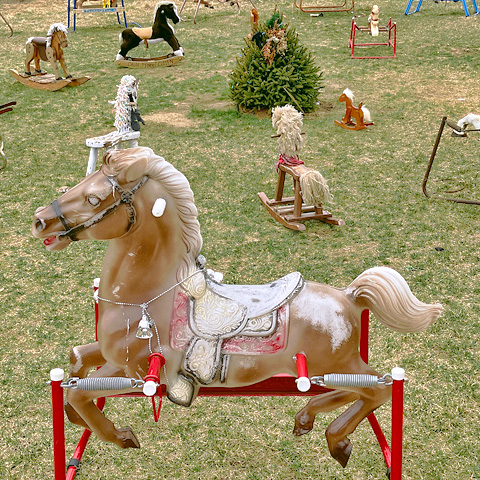 |
||
|
Now that we’re accustomed to the general appearance of thermal IR photos, let’s look at some issues and opportunities. |
||||
 |
← Below, a well-insulated wall, with a properly installed high-efficiency thermopane window. Note inferior window at upper left, and heat venting under rake boards – helps to keep roof insulation dry. Wall insulation may have settled, or hot air may be leaking into the wall space from a leaky duct. → |
 |
||
 |
← Window tight, frame warm. Installed correctly, but old-style frame conducts some heat. Note air leakage through shingled wall. Even a good window usually will not insulate as well as an average wall. Curtains or shades disrupt convective flow across the window’s interior, significantly reducing heat transfer. → |
 |
||
|
Both windows are single-glazed, but lower one has a good storm door outside. Ordinary window glass strongly absorbs and poorly transmits – but efficiently radiates – thermal IR. But its surface still reflects, here mirroring the photographer. |
 |
|||
 |
One storm window was left open, with heat escaping through single-glazed sash. Note heat loss through attic vent, suggesting inadequate attic floor insulation. Bright spot at left is kitchen range-hood exhaust. Walk-out basement is insulated. Exposed foundation is warmed in part by sun and heat conducted up from ground. |
|||
 |
← Storm windows left open here too, and an old fixed light (“picture window”), though double-glazed, has low R-value. Same window from the inside, showing heat loss via unprotected lower single-glazed sash. → (Note reflections in both.) |
 |
||
 |
Modern low-E glass in this window is good, but gasket and caulking both leak air. Dark streaks on wall show where a later caulk bead blocked airflow. Investment: ~10 minutes’ labor, 10¢ in materials. Result: no more cold drafts around the shower! |  |
||
 |
Bathroom ceiling vents usually leak some air in windy weather, even with internal flapper valve seating properly (helped by occasional vacuuming). |  |
||
 |
 |
Duplex wall outlets often provide access for cold air that penetrates sheathing or unsealed openings, then blows around inside the walls. | ||
| A simple, cheap foam insert behind this cover plate easily mitigated the draft. |  |
|||
 |
← Double-glazing on this skylight failed. Instead of a messy $2000 full replacement, the glass alone was swapped out neatly in 15 minutes for about $100. It is worth asking around to find high-service, low-cost contractors! Slider door tight, but old-style thermopane does not insulate as well as modern low-E glazing. → |
 |
||
 |
← Old wood door/storm door both leak badly. Replacing storm door ended major drafts. Loose main door still lets moisture condense on glazing, so reusable weather-stripping blocks gaps.
Warped storm and inner doors with excess clearance; rubber threshold gasket has decayed. Door is rarely used in winter, so “sausage” cushion blocks airflow until new gasket and exterior storm door arrive. → |
 |
||
| A look at plumbing | ||||
| Hose-bib covers are readily available. Total heat loss from bare through-wall pipes is fairly minor, but a freeze can crack valve and piping, causing an expensive and messy flood—possibly within the wall. |  |
|||
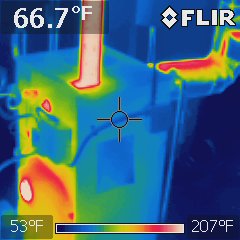 |
← Efficient steam boiler: exhaust (right) just a little warm and case mostly cool. Baseboard water boiler: return (front) shows one of two zone circulator pumps active. → Un-insulated pipes are one way to (over-)heat a cellar! |
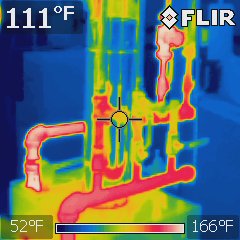 |
||
| When waste heat must be vented… | ||||
 |
← Multi-flue chimney, with unlined flue operating. Multi-flue chimney with lined flue operating, so brickwork remains cool. → |
 |
||
Heat and hot air can flow in either direction, so similar considerations apply to summer air-conditioning and solar-heat management |
||||
| Renovating a cathedral ceiling: former attic wall has some insulation; roof none. |  |
|||
 |
Warming up the chiller: ← Upstairs rooms are open to air. Downstairs rooms are naturally cool—see lower-left window. Idle AC unit in upper-right, cooled by breeze, contrasts with wall warmed by afternoon sun. Active AC unit heats up on the outside as interior cools. → |
 |
||
 |
← Chilled air blowing into room; window above and plastic sliders on each side conduct heat from outdoors … while indoor heat gets pumped back outside. → |
 |
||
| And all that energy must be imported from afar… Unless we grow, harvest, chop and split it ourselves! |
||||
This useful tool and fascinating educational toy
|
||||
 |
||||



